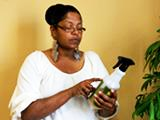Safety Issues in Controlling Bed Bugs
Many bed bug control techniques present some potential safety issues. Pay attention to these issues when choosing and implementing control methods.

Pesticides
When selecting and using pesticides, read and strictly follow the label directions. The label tells you:
- If the pesticide is approved for use against bed bugs (don't use it if it is not).
- How the product is to be applied and how often you can use it.
- Never use a pesticide indoors that is intended for outdoor use. It is very dangerous and won’t solve your bed bug problem.
- Where it can be used (e.g., in cracks and crevices, on mattresses, etc.).
- How you should protect yourself against overexposure (e.g., leave the treated area for a certain amount of time, wear gloves when applying, etc.).
- Whether or not EPA has registered the product. Keep in mind that any pesticide product without an EPA registration number on the label has not been reviewed by EPA, so we haven’t determined how well the product works.
- If there are any other potential concerns.
Even if you have used the product before, read the label each time you plan to use the product so you don't forget a step or a protective action. Reading the label also helps ensure you get the most effectiveness from the product.
Heat Treatments and Bed Bugs
Heat treatment can be a very effective means to control bed bugs. Residents can kill bed bugs using heat produced by the clothes dryer or a portable heat chamber. Professionals can also treat your entire residence, but care must be taken to ensure that it is done properly. Some things to look out for include:
- Choose professionals who have strong references and history of successful treatment.
- Properly handle heat-sensitive items so that they do not melt during treatment (these items should be treated using an alternative technique).
-
Put practices in place to avoid re-introducing bed bugs, since heat treatments have no residual effects.
For further information on heat treatments see Using Heat to Kill Bed Bugs (PDF).(4 pp, 156.08 K, About PDF) Exit
Using Cold to Control Bed Bugs
Although cold temperatures can kill bed bugs, this technique may require specialized equipment and knowledge. Home freezers do not always get cold enough to kill the bugs. Bed bugs can go dormant and appear dead for days and then become active again once they are warm.
Other techniques, such as the use of carbon dioxide, have their limitations and often are most effective as components of a more comprehensive bed bug control plan. There may also be some safety concerns with these techniques, depending on how they are used. Like registered pesticide applications, these treatments have the potential to damage materials and may pose risks to humans and animals. Treatments as seemingly innocuous as carbon dioxide can be fatal if applied incorrectly.
